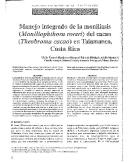| dc.contributor.author | Krauss, U. | |
| dc.contributor.author | ten Hoopen, M. | |
| dc.contributor.author | Hidalgo, E. | |
| dc.contributor.author | Martínez, A. | |
| dc.contributor.author | Arroyo, C. | |
| dc.contributor.author | García, J. | |
| dc.contributor.author | Portuguez, A. | |
| dc.contributor.author | Sánchez, V. | |
| dc.date.accessioned | 2015-03-19T21:52:27Z | |
| dc.date.available | 2015-03-19T21:52:27Z | |
| dc.date.issued | 2003 | |
| dc.identifier | 420756 | es_ES |
| dc.identifier.issn | 1022-7482 | es_ES |
| dc.identifier.uri | https://repositorio.catie.ac.cr/handle/11554/6554 | |
| dc.description | 5 ilus. 2 tab. 9 ref. | es_ES |
| dc.description.abstract | La moniliasis es el factor más limitante en la producción de cacao en Talamanca. Una evaluación participativa del manejo cultural y biológico de la moniliasis en pequeñas fincas orgánicas fue llevada a cabo. Se evaluó la remoción semanal y quincenal de frutos enfermos y siete tratamientos biológicos. La remoción semanal redujo la moniliasis significativamente, a través de una reducción en esporulación. Ambos regímenes de remoción de mazorcas enfermas mejoraron los rendimientos, pero solamente la remoción semanal aumentó el porcentaje de mazorcas sanas. Cuatro tratamientos biológicos redujeron la moniliasis con incrementos de rendimientos hasta el 50 por ciento. Los ensayos coincidieron con años de muy baja producción y ni el control cultural, ni el control biológico resultaron económicos. Sin embargo, un modelo matemático previamente desarrollado indicó que extrapolando a un año normal, la remoción fitosanitaria en intervalos quincenales resultó económica en pequeñas fincas manejadas por la familia, pero no en áreas con otras opciones de trabajo remuneradas. Se pronosticó que tres aplicaciones de biocontroladores seguidas por remociones fitosanitarias en intervalos quincenales maximizarían las ganancias. Esta estrategia integrada también coincide con las preferencias de los agricultores. Moniliasis is the most limiting factor of cocoa production in Talamanca. Participatory evaluation of cultural and biological control in organic smallholdings was carried out. Weekly and fortnightly removal of diseased fruits and seven biological treatments were tested. Weekly phytosanitation reduced moniliasis significantly via a reduction in sporulation. Both regimes increased yields, but only weekly removal increased the percentage of healthy pods. Four biological treatments reduced moniliasis with yield improvements of up to 50 per cent. The trials were carried out in years of extremely low production and neither cultural, nor biological control were economical. Nevertheless, using a previously developed computer model, extrapolation to a normal year indicated that fortnightly phytosanitation should be economical on family-run smallholdings but not where alternative employment exists. Three applications of biocontrol agents, followed by fortnightly phytosanitation are predicted to maximize profits. This integrated strategy also coincides with farmers' preferences. | es_ES |
| dc.language.iso | es | es_ES |
| dc.publisher | CATIE, Turrialba (Costa Rica) | es_ES |
| dc.relation.ispartof | Agroforestería en las Américas v. 10 n. 37-38 p. 52-58 | |
| dc.subject | THEOBROMA CACAO | es_ES |
| dc.subject | MONILIOPHTHORA | es_ES |
| dc.subject | LUCHA INTEGRADA | es_ES |
| dc.subject | ENFERMEDADES FUNGOSAS | es_ES |
| dc.subject | EPIDEMIOLOGIA | es_ES |
| dc.subject | AGRICULTURA ORGANICA | es_ES |
| dc.subject | CONTROL BIOLOGICO | es_ES |
| dc.subject | CONTROL CULTURAL | es_ES |
| dc.subject | CONTROL DE ENFERMEDADES | es_ES |
| dc.subject | METODOS DE CONTROL | es_ES |
| dc.subject | GESTION DE LUCHA INTEGRADA | es_ES |
| dc.subject | COSTA RICA | es_ES |
| dc.title | Manejo integrado de moniliasis (Moniliophthora roreri) del cacao (Theobroma cacao) en Talamanca, Costa Rica | es_ES |
| dc.title.alternative | Integrated management of moniliasis (Moniliophthora roreri) of cacao (Theobroma cacao) in Talamanca, Costa Rica | |
| dc.type | Artículo | es_ES |


